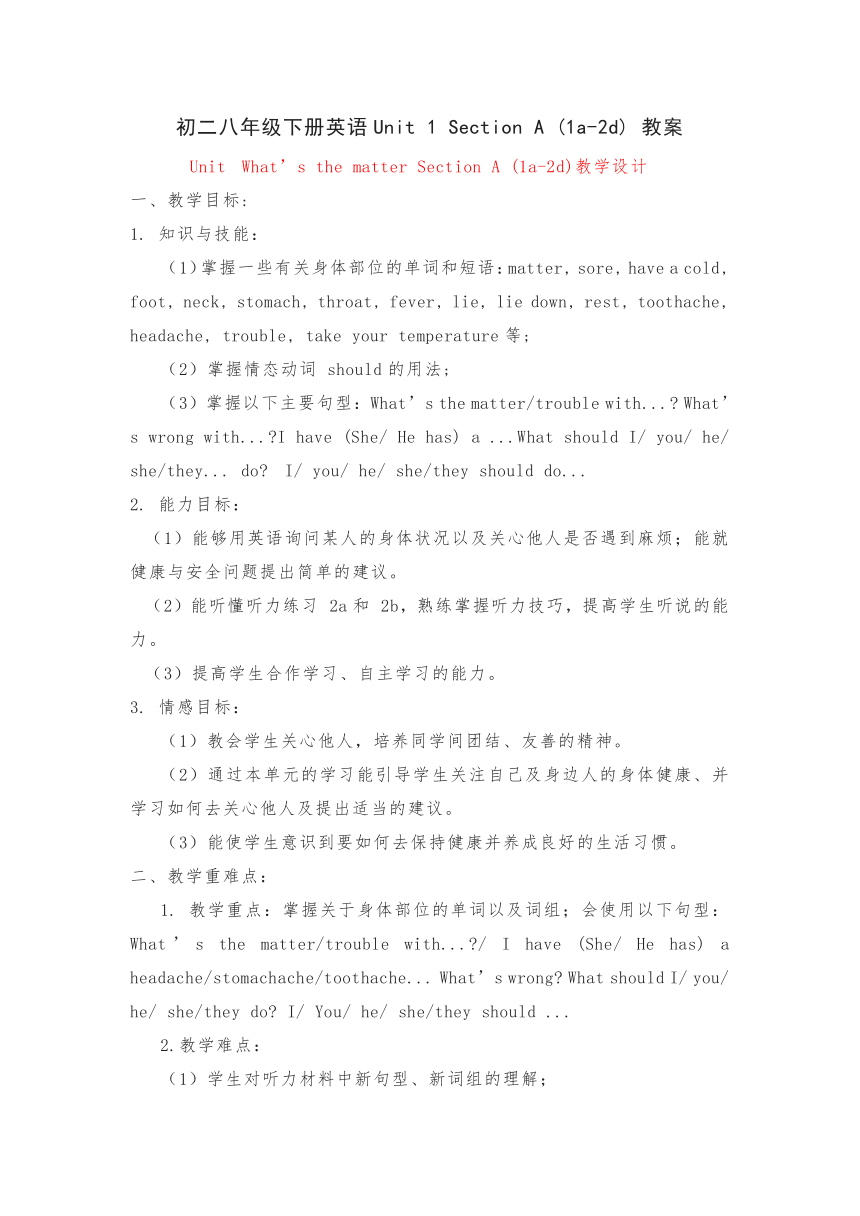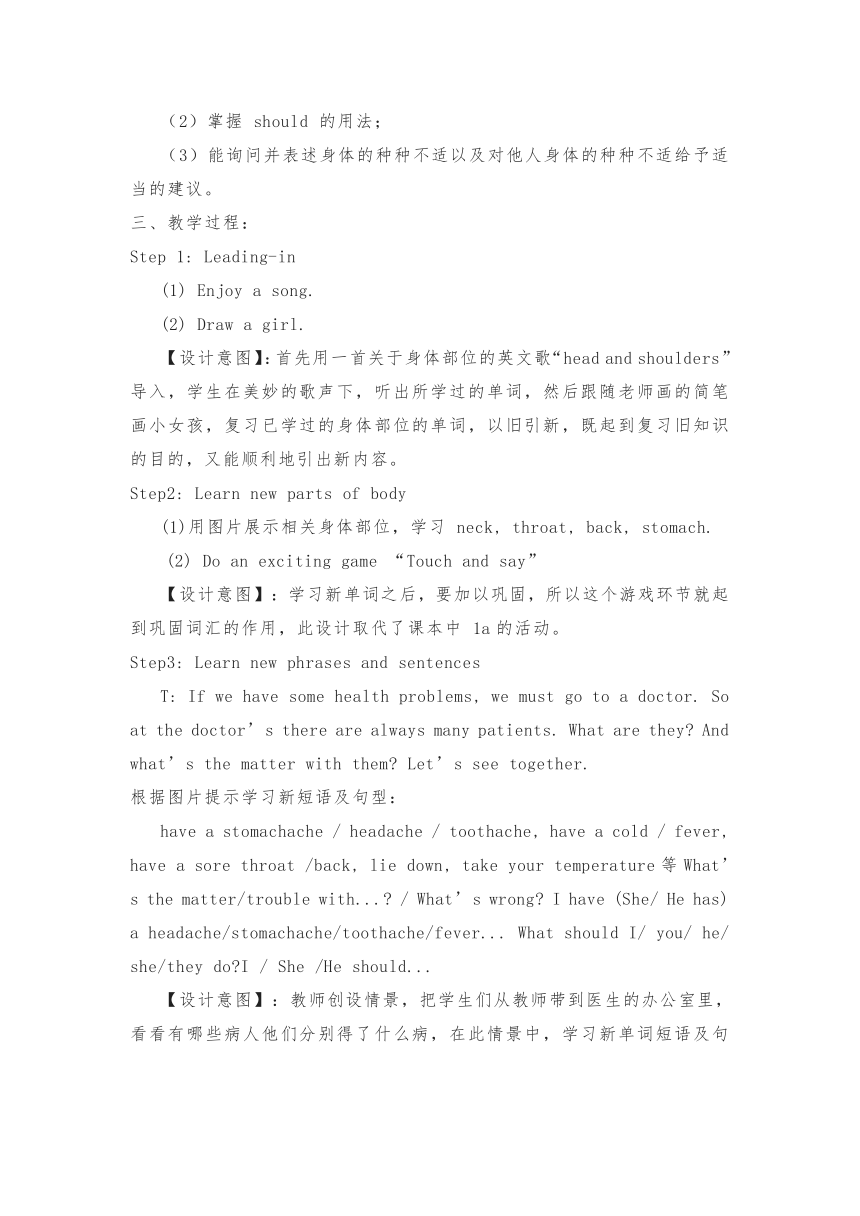初二八年级下册英语Unit 1 What's the matter? Section A (1a-2d) 教案
文档属性
| 名称 | 初二八年级下册英语Unit 1 What's the matter? Section A (1a-2d) 教案 |  | |
| 格式 | zip | ||
| 文件大小 | 17.4KB | ||
| 资源类型 | 教案 | ||
| 版本资源 | 人教新目标(Go for it)版 | ||
| 科目 | 英语 | ||
| 更新时间 | 2023-02-27 08:37:22 | ||
图片预览


文档简介
初二八年级下册英语Unit 1 Section A (1a-2d) 教案
Unit What’s the matter Section A (1a-2d)教学设计
一、教学目标:
1. 知识与技能:
(1)掌握一些有关身体部位的单词和短语:matter, sore, have a cold, foot, neck, stomach, throat, fever, lie, lie down, rest, toothache, headache, trouble, take your temperature等;
(2)掌握情态动词 should的用法;
(3)掌握以下主要句型:What’s the matter/trouble with... What’s wrong with... I have (She/ He has) a ...What should I/ you/ he/ she/they... do I/ you/ he/ she/they should do...
2. 能力目标:
(1)能够用英语询问某人的身体状况以及关心他人是否遇到麻烦;能就健康与安全问题提出简单的建议。
(2)能听懂听力练习 2a和 2b,熟练掌握听力技巧,提高学生听说的能力。
(3)提高学生合作学习、自主学习的能力。
3. 情感目标:
(1)教会学生关心他人,培养同学间团结、友善的精神。
(2)通过本单元的学习能引导学生关注自己及身边人的身体健康、并学习如何去关心他人及提出适当的建议。
(3)能使学生意识到要如何去保持健康并养成良好的生活习惯。
二、教学重难点:
1. 教学重点:掌握关于身体部位的单词以及词组;会使用以下句型:What’s the matter/trouble with... / I have (She/ He has) a headache/stomachache/toothache... What’s wrong What should I/ you/ he/ she/they do I/ You/ he/ she/they should ...
2.教学难点:
(1)学生对听力材料中新句型、新词组的理解;
(2)掌握 should 的用法;
(3)能询问并表述身体的种种不适以及对他人身体的种种不适给予适当的建议。
三、教学过程:
Step 1: Leading-in
(1) Enjoy a song.
(2) Draw a girl.
【设计意图】:首先用一首关于身体部位的英文歌“head and shoulders”导入,学生在美妙的歌声下,听出所学过的单词,然后跟随老师画的简笔画小女孩,复习已学过的身体部位的单词,以旧引新,既起到复习旧知识的目的,又能顺利地引出新内容。
Step2: Learn new parts of body
(1)用图片展示相关身体部位,学习 neck, throat, back, stomach.
(2) Do an exciting game “Touch and say”
【设计意图】:学习新单词之后,要加以巩固,所以这个游戏环节就起到巩固词汇的作用,此设计取代了课本中 1a的活动。
Step3: Learn new phrases and sentences
T: If we have some health problems, we must go to a doctor. So at the doctor’s there are always many patients. What are they And what’s the matter with them Let’s see together.
根据图片提示学习新短语及句型:
have a stomachache / headache / toothache, have a cold / fever, have a sore throat /back, lie down, take your temperature等What’s the matter/trouble with... / What’s wrong I have (She/ He has) a headache/stomachache/toothache/fever... What should I/ you/ he/ she/they do I / She /He should...
【设计意图】:教师创设情景,把学生们从教师带到医生的办公室里,看看有哪些病人他们分别得了什么病,在此情景中,学习新单词短语及句型。创设具体情景,接近了生活的真实语言环境,这有利于学生理解和掌握对话内容。
Step 4: Pair work同桌间就所学内容进行对话练习。
【设计意图】:学以致用,会询问别人的病情并能做出回答,此环节是对已学内容的复习及巩固,起到查缺补漏的作用,让学生之间相互交流和学习。
Step 5: Listen to 2a
T: During our daily life, if our friends or parents have some health problems, we should care for them. And ask “what’s the matter ” So let’s see what are they and what’s the matter with them.教师再次创设情景,当我们的朋友家人有健康问题时,应主动关心并询问。
【设计意图】:此次情景创设,一是为了复习之前所学知识,二是为了听力练习做铺垫,教师带领学生很好地对听力材料中的图片进行分析,做到有的放矢,降低听力难度,帮助学生顺利完成听力练习,并能培养学生良好的听力习惯。
Step 6: Listen to 2b
T: If I have a fever, what should I do Can you give me some good advice If my father has a toothache, what should he do If my mother has a stomachache, what should she do
【设计意图】:
教师以问题的形式,带领学生先来学习和熟悉听力内容,学习新短语以及怎样给出合理的建议。
Step 7: Give advice
T: This is my best friend, today, she has a cold. And she asks for help. Can you give her
【设计意图】:学以致用,用所学内容给出别人建议,还能打开学生们的思维,集思广益,帮助别人,同时,还能激发学生关心他人帮助他人的热情。
Step 8: Role play
Imagine you are the school doctor. A few students have health problems. Make a conversation between the doctor and the students.
【设计意图】:小组活动,让学生扮演医生和病人,模拟看病的过程,贴近生活,让学生在交际的同时,体验生活。通过这个活动,把生活中的交际场合搬进课堂,使课堂变为一种具体的社会交往环境,使教学过程成为教师与学生之间的一个交际过程。
Step 9: Make a summary
教师带领学生一起总结本节课所学内容,学生齐读,并着重强调本节课学习的重要性。
【设计意图】:复习本节课所学知识,回顾知识,使学生有的放矢,明确重点知识,以便系统掌握。
Step 10: Love education and teacher’s suggestions学生齐读,感受爱的教育。
【设计意图】:此环节为情感教育环节,让学生懂得要爱护自己的身体,关爱自己的同时也要关心他人。能使学生意识到要保持健康并养成良好的生活习惯。
Step 11: Homework
According to the prompts, you’ll write a note for leaving to your English teacher.
Problems: have a fever, have a cold, have a stomachache, have a toothache...
Doctor’s advice: lie down and rest; drink water with honey; see a dentist and get an X-ray; take your temperature ...
Dear Miss Cao,
I’m sorry to tell you that I don’t feel very well. I_______________________________________________________________________________________________________________________________________________________________________________________________________________________________________________________
【设计意图】:此环节为课外作业,让学生学以致用,通过给老师写请假条的这种方式既巩固复习了本节课所学内容,也是一次写作的锻炼,将所学内容以书面方式输出。四、板书设计neck, throat, back, stomach
A: What’s the matter/trouble with... / What’s wrong
cold /fever.
B: I have (She/ He has) a headache/stomachache/toothache sore throat/back.
A: What should I/ you/ he/ she/do
B: I / She /He should...
【设计意图】:教师板书重点单词短语及句型,板书明确,一目了然,重难点突出,便于学生形成良好的知识体系,方便系统记忆。
Unit What’s the matter Section A (1a-2d)教学设计
一、教学目标:
1. 知识与技能:
(1)掌握一些有关身体部位的单词和短语:matter, sore, have a cold, foot, neck, stomach, throat, fever, lie, lie down, rest, toothache, headache, trouble, take your temperature等;
(2)掌握情态动词 should的用法;
(3)掌握以下主要句型:What’s the matter/trouble with... What’s wrong with... I have (She/ He has) a ...What should I/ you/ he/ she/they... do I/ you/ he/ she/they should do...
2. 能力目标:
(1)能够用英语询问某人的身体状况以及关心他人是否遇到麻烦;能就健康与安全问题提出简单的建议。
(2)能听懂听力练习 2a和 2b,熟练掌握听力技巧,提高学生听说的能力。
(3)提高学生合作学习、自主学习的能力。
3. 情感目标:
(1)教会学生关心他人,培养同学间团结、友善的精神。
(2)通过本单元的学习能引导学生关注自己及身边人的身体健康、并学习如何去关心他人及提出适当的建议。
(3)能使学生意识到要如何去保持健康并养成良好的生活习惯。
二、教学重难点:
1. 教学重点:掌握关于身体部位的单词以及词组;会使用以下句型:What’s the matter/trouble with... / I have (She/ He has) a headache/stomachache/toothache... What’s wrong What should I/ you/ he/ she/they do I/ You/ he/ she/they should ...
2.教学难点:
(1)学生对听力材料中新句型、新词组的理解;
(2)掌握 should 的用法;
(3)能询问并表述身体的种种不适以及对他人身体的种种不适给予适当的建议。
三、教学过程:
Step 1: Leading-in
(1) Enjoy a song.
(2) Draw a girl.
【设计意图】:首先用一首关于身体部位的英文歌“head and shoulders”导入,学生在美妙的歌声下,听出所学过的单词,然后跟随老师画的简笔画小女孩,复习已学过的身体部位的单词,以旧引新,既起到复习旧知识的目的,又能顺利地引出新内容。
Step2: Learn new parts of body
(1)用图片展示相关身体部位,学习 neck, throat, back, stomach.
(2) Do an exciting game “Touch and say”
【设计意图】:学习新单词之后,要加以巩固,所以这个游戏环节就起到巩固词汇的作用,此设计取代了课本中 1a的活动。
Step3: Learn new phrases and sentences
T: If we have some health problems, we must go to a doctor. So at the doctor’s there are always many patients. What are they And what’s the matter with them Let’s see together.
根据图片提示学习新短语及句型:
have a stomachache / headache / toothache, have a cold / fever, have a sore throat /back, lie down, take your temperature等What’s the matter/trouble with... / What’s wrong I have (She/ He has) a headache/stomachache/toothache/fever... What should I/ you/ he/ she/they do I / She /He should...
【设计意图】:教师创设情景,把学生们从教师带到医生的办公室里,看看有哪些病人他们分别得了什么病,在此情景中,学习新单词短语及句型。创设具体情景,接近了生活的真实语言环境,这有利于学生理解和掌握对话内容。
Step 4: Pair work同桌间就所学内容进行对话练习。
【设计意图】:学以致用,会询问别人的病情并能做出回答,此环节是对已学内容的复习及巩固,起到查缺补漏的作用,让学生之间相互交流和学习。
Step 5: Listen to 2a
T: During our daily life, if our friends or parents have some health problems, we should care for them. And ask “what’s the matter ” So let’s see what are they and what’s the matter with them.教师再次创设情景,当我们的朋友家人有健康问题时,应主动关心并询问。
【设计意图】:此次情景创设,一是为了复习之前所学知识,二是为了听力练习做铺垫,教师带领学生很好地对听力材料中的图片进行分析,做到有的放矢,降低听力难度,帮助学生顺利完成听力练习,并能培养学生良好的听力习惯。
Step 6: Listen to 2b
T: If I have a fever, what should I do Can you give me some good advice If my father has a toothache, what should he do If my mother has a stomachache, what should she do
【设计意图】:
教师以问题的形式,带领学生先来学习和熟悉听力内容,学习新短语以及怎样给出合理的建议。
Step 7: Give advice
T: This is my best friend, today, she has a cold. And she asks for help. Can you give her
【设计意图】:学以致用,用所学内容给出别人建议,还能打开学生们的思维,集思广益,帮助别人,同时,还能激发学生关心他人帮助他人的热情。
Step 8: Role play
Imagine you are the school doctor. A few students have health problems. Make a conversation between the doctor and the students.
【设计意图】:小组活动,让学生扮演医生和病人,模拟看病的过程,贴近生活,让学生在交际的同时,体验生活。通过这个活动,把生活中的交际场合搬进课堂,使课堂变为一种具体的社会交往环境,使教学过程成为教师与学生之间的一个交际过程。
Step 9: Make a summary
教师带领学生一起总结本节课所学内容,学生齐读,并着重强调本节课学习的重要性。
【设计意图】:复习本节课所学知识,回顾知识,使学生有的放矢,明确重点知识,以便系统掌握。
Step 10: Love education and teacher’s suggestions学生齐读,感受爱的教育。
【设计意图】:此环节为情感教育环节,让学生懂得要爱护自己的身体,关爱自己的同时也要关心他人。能使学生意识到要保持健康并养成良好的生活习惯。
Step 11: Homework
According to the prompts, you’ll write a note for leaving to your English teacher.
Problems: have a fever, have a cold, have a stomachache, have a toothache...
Doctor’s advice: lie down and rest; drink water with honey; see a dentist and get an X-ray; take your temperature ...
Dear Miss Cao,
I’m sorry to tell you that I don’t feel very well. I_______________________________________________________________________________________________________________________________________________________________________________________________________________________________________________________
【设计意图】:此环节为课外作业,让学生学以致用,通过给老师写请假条的这种方式既巩固复习了本节课所学内容,也是一次写作的锻炼,将所学内容以书面方式输出。四、板书设计neck, throat, back, stomach
A: What’s the matter/trouble with... / What’s wrong
cold /fever.
B: I have (She/ He has) a headache/stomachache/toothache sore throat/back.
A: What should I/ you/ he/ she/do
B: I / She /He should...
【设计意图】:教师板书重点单词短语及句型,板书明确,一目了然,重难点突出,便于学生形成良好的知识体系,方便系统记忆。
同课章节目录
- Unit 1 What's the matter?
- Section A
- Section B
- Unit 2 I'll help to clean up the city parks.
- Section A
- Section B
- Unit 3 Could you please clean your room?
- Section A
- Section B
- Unit 4 Why don't you talk to your parents?
- Section A
- Section B
- Unit 5 What were you doing when the rainstorm came
- Section A
- Section B
- Review of Units 1-5
- Unit 6 An old man tried to move the mountains.
- Section A
- Section B
- Unit 7 What's the highest mountain in the world?
- Section A
- Section B
- Unit 8 Have you read Treasure Island yet?
- Section A
- Section B
- Unit 9 Have you ever been to a museum?
- Section A
- Section B
- Unit 10 I've had this bike for three years.
- Section A
- Section B
